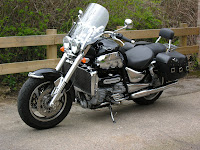Triumph Rocket III
 |
| Triumph Rocket III Classic Motorcycle |
History
The Rocket III Project started in 1998 led by Triumph Product Range Manager Ross Clifford and started with a lot of research—especially in the USA where big cruisers were selling well. The main competitors were the Harley-Davidson Ultraglide and the Honda Goldwing so the initial idea was to develop a 1,600 cc performance cruiser.The in-house designer was John Mockett, designer of the Hesketh V1000, the Tiger and the new 'nostalgia' Bonneville. He started work with David Stride, Gareth Davies and Rod Scivyer working around an in-line three cylinder engine. At the start of the project in-line four and a V6 engine configurations were looked at but the longitudinally mounted triple design led to the design concept code named C15XB Series S1.
Mockett experimented with ‘futuristic’ styling that included "raygun" mufflers and a large chrome rear mudguard, but consumer focus groups didn’t like it. The S2 model was a simplified version with a more traditional rear mudguard and several features that were to make it through to the final design. Once again, the feedback from market research was that it was still too radical so the lines were simplified and smoothed out to create the Series S3.
 |
| Triumph Rocket III Classic Motorcycle |
Part of the reason for the secrecy was competition from other manufacturers. Yamaha launched the 1,670 cc (102 cu in) (badged as a 1,700 cc) engine in 2002, with the introduction of the Road Star Warrior and Honda launched the VTX1800, so a decision was made to go for a displacement of 2,294 cc.
The first engine was built in summer 2002 and tested in the autumn. Twin butterfly valves for each throttle body were used to increase control and allow the ECU to vary the mixture flow and ignition map according to the gear selected and speed. The torque curve is modified for each gear ratio, enabling over 90% of the engine’s torque output at 2,000 rpm, giving the high levels of flexibility that the designers needed. The 1,500 W starter motor on the Rocket III puts out as much power as the engine on the very first Triumph motorcycle, Siegfried Bettman's 1902 1.75 horsepower (1.30 kW) single.
The final design of the S3 prototype had a large tubular steel twin-spine frame, designed by James Colbrook. Andy Earnshaw was responsible for designing the gearbox and shaft drive to a 240/50ZR16 bike specific rear tyre. High specification front brakes were twin four-piston callipers with 320 mm floating discs and the rear brake, developed specifically for the purpose, was a single twin piston calliper and 316 mm disc. Ride handling is controlled by purpose built rear shocks and 43 mm 'inverted' front forks.
Road tests proved that the weight distribution, low centre of gravity and geometry allowed acceleration up to 135 mph (217 km/h). In 2004, the Rocket III set the world land speed record for a production motorcycle over 2000 cc reaching its electronically set limiter of 140.3 mph (225.8 km/h).
In 2003, the prototype was renamed the 'Rocket', following market research, continuing the heritage of famous British BSA Rocket motorcycles. It was unveiled in the USA on 20 August 2003, in San Antonio, Texas. The Rocket's European launch was at the International Motorcycle Show in Milan, Italy on 16 September 2003. Sold in the UK from the spring of 2004, it was awarded 'Machine of the Year' by Motorcycle News at the 2004 NEC Motorcycle Show. The Australian launch was in Sydney in August 2004, with 230 deposits taken before any had been shipped into the country.
Models
Rocket III
 |
| Triumph Rocket III Classic Motorcycle |
Rocket III Classic
Introduced in 2006, the Classic version has rider floorboards, different shaped silencers (mufflers) and 'pullback' handlebars. More colour choices were added and the pillion seat was modified to improve comfort.In June 2007 Triumph used 'viral marketing' to promote the Rocket III Classic by posting a well made spoof production video to YouTube and bike enthusiast websites, As of September 2010 the video had more than 930,000 views.
Rocket III Tourer
The short-lived 2007 Tourer Limited Edition Model was just a Classic Model with the addition of a windscreen, panniers (saddlebags), backrest and luggage rack from the factory, and a choice of two-tone paint schemesRocket III Touring
Triumph began developing the Rocket III Touring version in February 2004 following the launch of the original model, to target the large cruiser market which represents 50% of all US motorcycle sales. As well as a new design for the steel frame and swinging arm, the Touring model has more torque at lower revs – 209 N·m (154 ft·lbf) @ 2,025 rpm, but less horsepower at the top end. New features include tank mounted instruments and a scrolling switch on the handlebar to set the clock and indicate fuel ranges The five-spoe design used on the Rocket III was replaced with billet aluminium slotted wheels and narrower tyres were specified to improve steering with a 180/70 x 16 rear tyre to make it easier to fit detachable panniers that come as standard, together with a removable windscreen and Kayaba rear shock absorbers.

